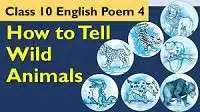
How to Tell Wild Animals is a great poem which is well explained by Edumantra paying special attention on How to Tell Wild Animals Introduction, Message from How to Tell Wild Animals, Theme of the chapter How to Tell Wild Animals, How to Tell Wild Animals Title, Characters of How to Tell Wild Animals, Summary in English, Summary in Hindi, Word meanings, Complete lesson in Hindi, Extracts, Long answers, Short answers pdf How to Tell Wild Animals, Very short Answers, MCQs from How to Tell Wild Animals and much more
How to Tell Wild Animals
By– Carolyn Wells
Carolyn Wells – A Short Biography
About the Poetess
Carolyn Wells was an American poet. She was born in Rahway, New Jersey, in the United States of America on 18 June 1862, to Anna Wells and William Wells. She was married to Hadwin Houghton. After finishing her school, she worked as a librarian for the Rahway Library Association. Her first book was published in 1896.
Introduction of the lesson- How to Tell Wild Animals
INTRODUCTION
This humorous poem suggests some dangerous ways to identify wild animals. The poet gives a beautiful description of the Asian Lion and the Bengal Tiger. Then he points out about the Leopard and the Bear. He describes the Hyena for its smiling face and the crocodile for its tears. Then the poet describes how the Chameleon changes its colour.
(यह हास्यप्रद कविता जंगली जानवरों की पहचान करने के बारे में और कुछ खतरनाक तरीकों का वर्णन करती है ।कविएशियाई शेर और बंगाल के बाघ का बड़ा सुंदर वर्णन करता है । तब वह चीते और भालू की पहचान के बारे में बताता है ।वह लकड़बग्घे का वर्णन उसके मुस्कुराते हुए चेहरे से और मगरमच्छ का वर्णन उसके आंसुओं से करता है।तब कवि इस बात का भी वर्णन करता है कि गिरगिट अपना रंग कैसे बदलता है।)
Want to Read More Check Below:-
How to Tell Wild Animals- Theme & Style of the Poem
How to Tell Wild Animals- Short & Detailed Summary
How to Tell Wild Animals- Value Points of the Poem
How to Tell Wild Animals- Summary in Hindi – Full Text
How to Tell Wild Animals- Multiple Choice Questions in Quiz
How to Tell Wild Animals- Passages for Comprehension
How to Tell Wild Animals- Extract Based comprehension test Questions
How to Tell Wild Animals- Important Extra Questions- Very Short Answer Type
How to Tell Wild Animals- Important Extra Questions- Short Answer Type
How to Tell Wild Animals- Important Extra Questions- Long Answer Type